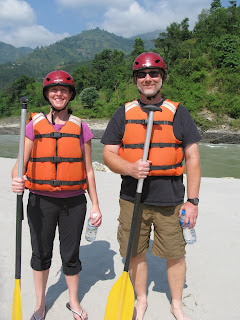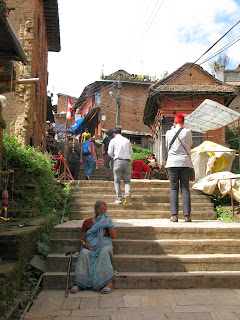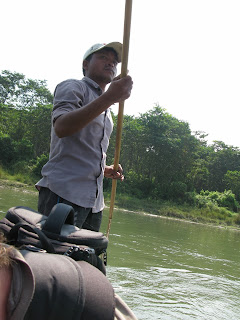There is one main highway in Nepal. It's two lanes, and they are narrow lanes. Outside of Kathmandu, the roads wind through hills and mountains, and there are many sheer dropoffs with no guard rails.
And it's a relief when you hit a stretch of highway that is smooth and solid asphalt. A great portion of the highway is pitted with potholes. Big deep potholes. And for that reason, a good portion of the time, cars and buses and trucks and motorcycles go around 40 kmph. You feel like saying "woo-hoo!" when the road and traffic is good enough to hit 60 kmph, maybe even 80 kmph. But that doesn't last long!
And in the city, there are some pitted roads as well, but overall not as bad as the highway.
Vehicles pass each other on these two-lane windy roads. We thought the driving in the UAE was on the risky side. Oh no. The UAE has nothing on Nepal. In fact, when we got back to the UAE and were in a taxi back to the villa, it was refreshing that the taxi was keeping a car's length behind the next car. In Nepal, that the bumpers of vehicles are actually not touching or hitting each other is remarkable.
There's a system to the risk-filled passing of other vehicles. You just trust, and you pray, that the drivers around you know the signals and are adhering to them.
For example ... people honk a lot, but they are short honks, to let other drivers know where you are. When you want to pass another vehicle, you honk. On the windy highway, if it's clear to pass, the vehicle (usually a big truck) will turn on its right turn indicator. If it's not clear, the driver uses the left turn indicator.
The bumpers of trucks actually have words on them, such as "honk to pass" or "wait for turn signal".
Now, "clear to pass" is another term that means something different in Nepal. Clear to pass means you have a few seconds and the length of a car or two to get around the truck in front of you before another car or truck careening toward you in the other lane might, oh, graze your vehicle.
In the city, at first you feel some relief when you are on a road that has a white line down the middle. But then you realize that that line is simply decorative.
And some "roads" look like they should be for pedestrians only. But nope! This is a road that has traffic going both directions, as well as pedestrians, and shops on the side. (Picture this packed with pedestrians and more cars and rickshaws ... because that's it normally is. This quieter street was a fluke!)
Even this street was quieter than most ...
And colorful. The majority of trucks and buses are painted with bright colors, and are decorated.
Other modes of transportation include ...
Another kind of taxi called a tut-tut.
A type of rickshaw, colorfully decorated.
And these hauled goods, equipment, or people.
Because of the condition of the roads, it can take much longer to get places. For example, it's a mere 185 kilometers between Kathmandu and Chitwan National Park. And it takes 4.5-5 hours by car to get there. (Remember those top speeds of 40 kmph.) By air, this same distance is covered in 30 minutes max.
Getting to Chitwan, Seta our driver took us. We stopped about half-way, and did some white water rafting (that's another post coming up -- great fun!). We were supposed to fly back from Chitwan, instead of doing the 4.5 hour drive on an uncomfortable road. But ... the wrong tickets were booked, there were no seats available, and we ended up taking a taxi back to Kathmandu. About halfway through the 4.5 hour drive, I really needed to stop for a comfort break. But no way did I want us to pull over (there are a variety of toilets along the way) and lose our place in line on the road so to speak (our driver worked hard to pass and get in front of lumbering trucks and buses). Instead I focused on praying a lot when our (very good) driver passed vehicles with inches to spare or when our itty bitty taxi was sandwiched between buses and trucks with mere inches to spare, holding on to Tim's headrest in front me, and bracing my body against pothole after pothole.
Comparing notes later, all three of us had been praying to be out of the winding road and mountains before dark descended along with us, and we did so, with thanks.
This is the Nepal highway:
A beautiful view from the road(same river as the one we rafted on):
A few times we got a glimpse of snow covered Himalayan peaks. What we didn't manage were any good photos of them to share here, unfortunately.
Upon our return to the hotel (another post to come ... we highly recommend the place, and I'll share photos in an upcoming post), I beelined for the lobby restroom, after placing my order for a whisky :-) Then, detox from Mr. Toad's Wild Ride, thanking God for arriving unscathed.
Wishing everyone in the U.S. and from the U.S. a Happy Thanksgiving tomorrow! (And yup, managing to have some turkey myself -- some local restaurants are serving up Thanksgiving feasts and some friends and I are partaking.)







































































